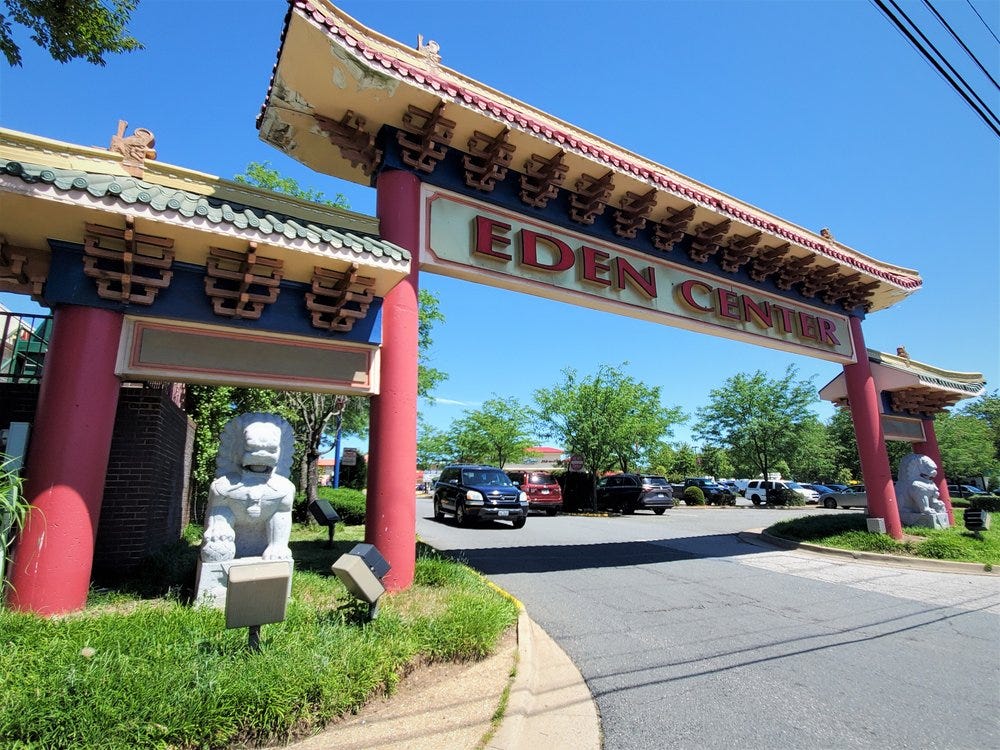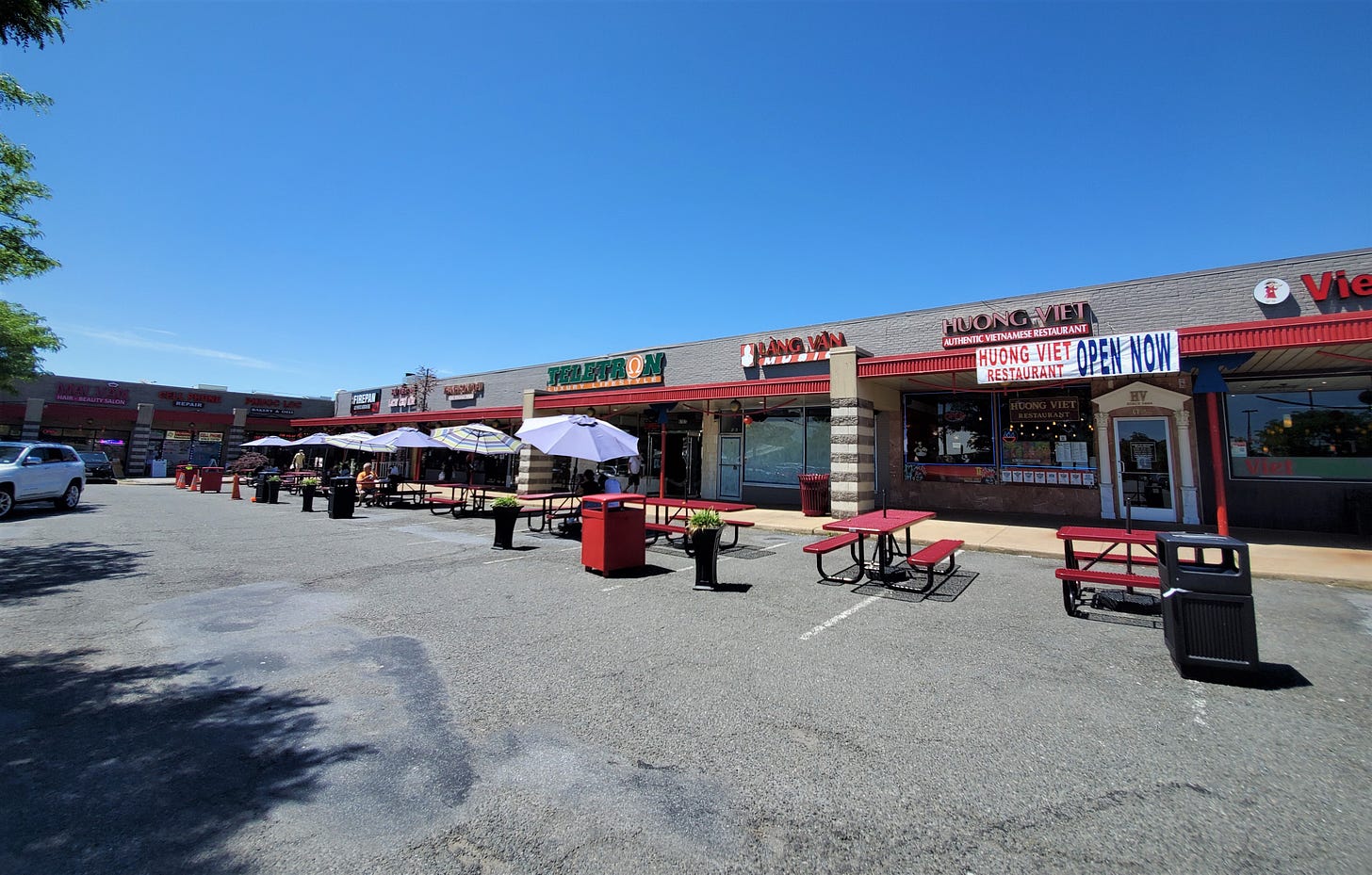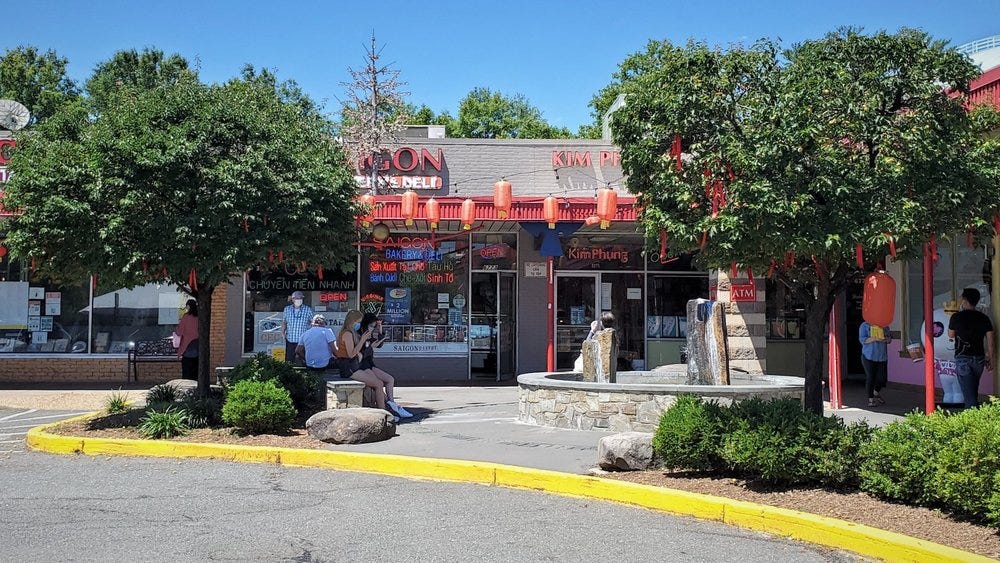What a Strip Mall Can Be
Northern Virginia's Eden Center is neither standard sprawl nor modern redevelopment
This is a strip mall:
I wrote about this shopping center, called Eden Center, for Strong Towns earlier this week: check out the piece. Eden Center is home to over 100 mostly independent/local businesses, the majority Vietnamese shops or restaurants. They cater to a large Vietnamese-American community in the region, but the place has also become one of the few tourist attractions in the D.C. suburbs.
Unlike the more modern developments that compete in some ways with the city—Reston Town Center further west in Northern Virginia, or a series of mixed-use developments around Rockville, Maryland—Eden Center fundamentally remains a strip plaza.
From my original piece:
This might all look merely cosmetic, but it’s more than that. Yes, Eden Center is a single property, and yes, it’s mostly reliant on the car. But it draws its energy from an astonishing number of small businesses. It’s more broad-based and less fragile than a “downtown-style,” mixed-use development, or a standard strip plaza anchored by chains. And all together, its features change the look and feel of the place considerably. It’s a really unique use of a substandard form. It’s squeezing water from a stone. And it can be done elsewhere, too.
The things that make Eden Center attractive—its high commercial density and concentration of businesses, its outdoor seating, it’s use of the space for cultural events, and its ornamentation—are cosmetic, in some ways. They’re more than that, but even cosmetic changes matter. If a little bit of ornamentation can enhance a matchstick box in the suburbs or a walk-up apartment building on main street, why can’t they enhance a strip mall?
I like Eden Center for its culinary and cultural interest, and because of the weird juxtaposition of this with its location. (It’s located around an area known as Seven Corners, a massive intersection of the region’s biggest highways, producing seven lonely juts of land which all house or once housed major shopping centers.)
But what interests me more here is Eden Center’s approach to enlivening a substandard built environment. There are lots of approaches to this—tear it all down and build a fake downtown, for example. Or approaches known as “sprawl repair” or “suburban retrofit.” Or, of course, the “Strong Towns approach.”
Much of what Strong Towns writes about focuses on urban environments—small towns and urban neighborhoods—and how those places can put people first and build wealth that sustains the place over time. The focus is not on transforming or redeveloping places wholesale, but on working with what you have and making slow, humble improvements.
The point of my piece is that this approach can also be applied to the very environments that urbanists often write off or ignore. Much of suburbia as currently constituted has to change in some way. Many think that will either be either the opposites of decay or total redevelopment. But what a place like Eden Center suggests is that a different kind of change is possible—more like an evolution, as people adapt these substandard forms, and as the kinds of businesses that inhabit them see a devolution in scale.
I don’t know how many stores originally existed in the plaza that is now Eden Center—it was built in the 1960s—but there’s absolutely no way it was 125, which is the number cited by the shopping center’s website. In 1999, this Washington Post article cites it as 100 even. (The center was expanded in 1996.) It’s unusual to see a strip mall actually grow the number of enterprises housed in it over the years, let alone with much of that growth not driven by physical expansion!
When you read about places like this, that have special appeal to a particular ethnic or immigrant community, you’ll often see that people drive hours to get to them. These places sort of function like urban downtowns: big agglomerations of businesses that are worth big, if occasional, visits and shopping trips. The standard suburban layout is actually hiding a lot of vitality and a lot of subtle adaptation.
We should think twice about redeveloping old suburban environments like this from the top down, in ways that treat these places as blank slates. It’s true that lot of postwar development is aging out, and that retail was overbuilt in the 20th century. It’s also true that many of these places now have a housing shortage. That’s a big reason large-scale mixed-use development is trendy right now.
But we’re also reaching a point where these suburban landscapes have gone through a few generations, and have taken on a life and complexity that their physical form fails to fully credit. This phenomenon is an embodiment of slow, cautious, incremental improvement, that involves and works with everyday people and small business owners.
And it also demonstrates that for all their flaws, these places are now deeply settled and full of meaning. We don’t really know how they’ll incrementally evolve in the next, say, 50 years. But I hope we’re able to find out.
Related Reading:
A Different Take on Suburban Parking Lots
Dollar Stores and Retail Evolution Revisited
Please consider upgrading to a paid subscription to help support this newsletter. You’ll get a weekend subscribers-only post, plus full access to the archive of over 200 posts and growing. And you’ll help ensure more material like this!








It should be pointed out that Eden center is an exact replica of a strip shopping center in Saigon, south Vietnam circa 1968. In fact every summer there is a reunion in the parking lot of soldiers who served in the South Vietnamese army.
One thing that strikes me about this situation is the small sizes of the spaces—to have 200 businesses in a mid sized plaza means that many have to be quite small. Small spaces lower the nut to get up and running and pay rent, allowing for more diverse businesses. The great number of interesting businesses make it a great destination. And it all comes back to lots of small spaces.
And here it gets really interesting: why isn’t this more commonly seen? Turns out small spaces are more expensive to build and operate. It’s more walls per sq ft of property, more doors, more fire alarms, more utility meters, etc. we should be looking for opportunities to creatively lower the cost of construction and make it more equal between small and chaotic and big and simple.